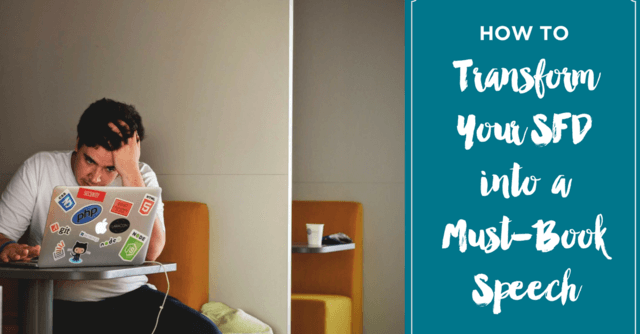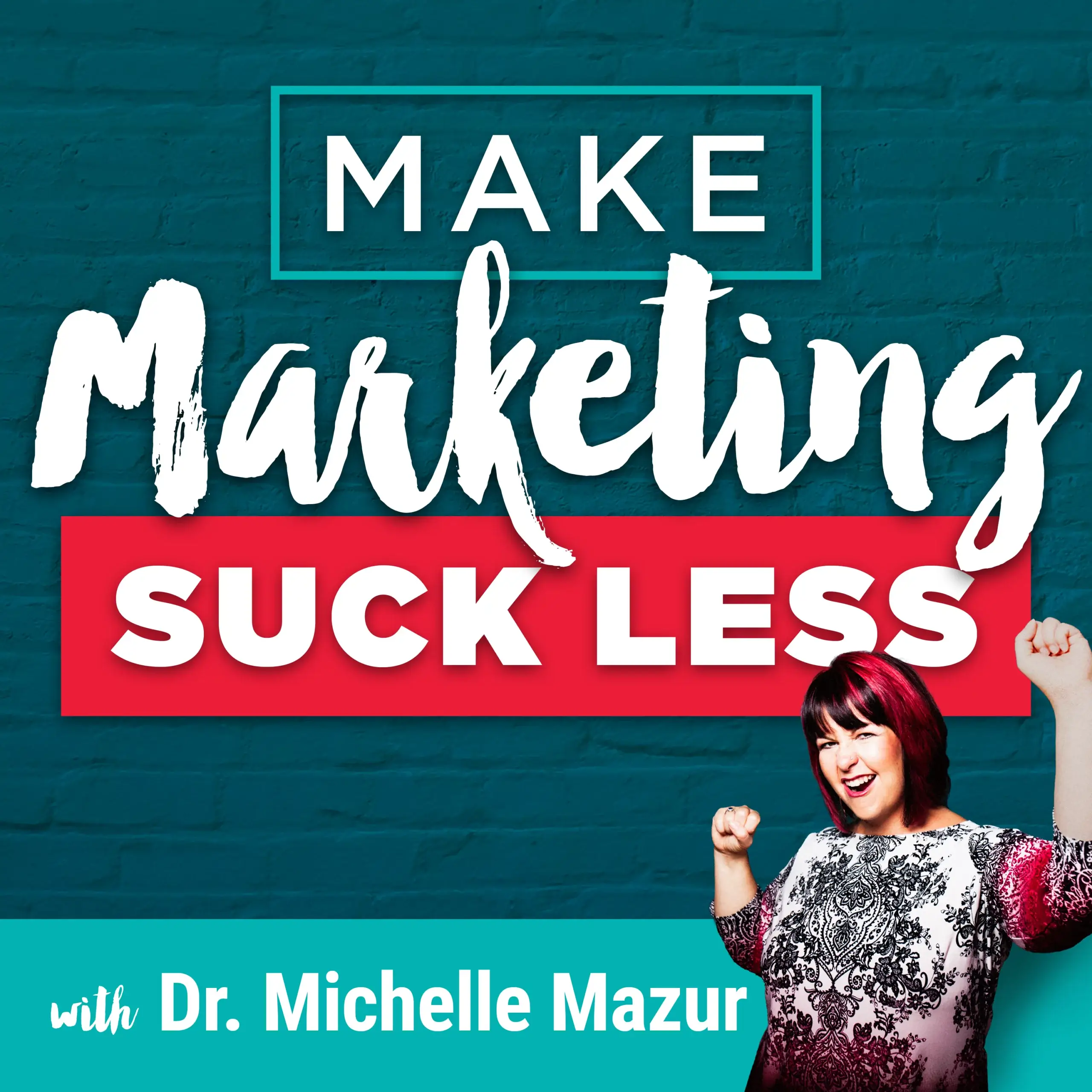Make Marketing Suck Less
5 Ways to Transform Your SFD Speech to an Applause-worthy, must-book Speech
By Michelle Mazur > May 9, 2017
Filed Under Craft Your Signature Talk

How do you take your SFD speech, your shitty first draft, and transform it into something that audiences are persuaded by?
That they are moved by?
That they are moved so much that they stand up and applaud after you're done speaking?
How do you transform that SFD into something that gets you referrals, and amazing testimonials, and more business from organizations?
The key to that is in the editing. I know, it's super sexy but this is what marks a pro speaker from an amateur.
Last week we covered the five phases of speech writing. I highly recommend you go back review that list if you haven't.
I mentioned in that list what I feel is the most chronically overlooked phase of creating a speech: Polishing and editing.
The magic of a speech writing happens in the editing.
Editing is where you can craft a better story, find better words, create more connection and build engagement with your audience.
It's important to spend a lot of time editing your speech.
This is a phase of speech writing you'll come back to again, and again, and again because you'll always find ways to make your speech better.
When I'm working with a client and we have their SFD, I will take the first pass through their speech. I look for five specific things during this first pass.
I'm going to walk you through how I begin to edit a speech so that you can do this as well.
[Tweet “The magic of speech writing happens in the editing.”]
Prefer to listen?
Table of Contents
Editing Magic Tip #1: Transitions
The number one thing I look for in an SFD is transitional statements.
Transitions are essentially how we get from Point A to Point B, or from our introduction to our first point.
Transitions tend to be the rocky spots because we haven't thought through how I'm going to get from my second point to my third point. What is that connecting material?
The first pass through a speech I'm always looking for how we're connecting the different ideas, the different stops in the audience journey, to the next stop.
Having those clear, crisp transitions makes a huge difference when you begin practicing your speech and giving your speech in front of an audience. That's one of the first things to look for:
How are you getting from the intro to point number one, or from point number three to the conclusion?
Editing Magic Tip #2: Cut the Warm up
After I've done a pass for transitions, the second item I look for is what I call warm up speech writing. Warm up speech writing is basically a concept where we tend to get informal with our audience. It's like we're having a conversation.
I see this all the time with introductions, when someone walks on stage and they're like,
“Oh, thank you so much for having me here tonight. I'm so grateful and wasn't traffic terrible?” Blah, blah, blah. Then they start.
That is all warm up copy and usually it doesn't happen in the speech if it's in the introduction or the speech writing. It's important to cut all of that stuff out.
If you have to pre-tell a story, like you're giving a lot of context around a story and explaining a story before you start actually telling it and experiencing it with the audience, all of that can be cut. Cut all the warm up speech writing.
Editing Magic Tip #3: Story Hooks
Then once I've cut the warm up speech writing, I go through and I start looking for story hooks.
Because human beings are terrible, terrible story tellers. Especially in speaking, we tend to explain a story rather than tell it, relive it, invite the audience into it.
What I do is I try to find the hooks in different stories that are being told. They're going to grab the audience’s attention and get them involved in the story immediately.
Usually, when I'm looking for a hook I'm looking for the strong emotions that are happening in the story, or something that's fun, and weird, and quirky, and a little bit different, or outrageous, or bold.
If we can identify two or three of those for every story that a client is using in a speech, then we can play with them and figure out what would be the best hook for each story.
Editing Magic Tip #4: Specificity
The fourth thing that I look for is specificity. Specificity in a speech allows the audience to better visualize.
When I talk about being specific, I'm not talking about being overly detailed. I'm not talking about Tolkien's the Hobbit, where he describes the Shire for 200 pages. Which is why I never got through any of the Lord of the Rings or finished The Hobbit books, because there is just too much explaining and description.
You want to create moments of specificity so that the audience can visualize and then fill in the blanks.
For instance, if in your speech someone is wearing slippers, you could say they're wearing slippers and people would have a variety of different ideas of what the slippers look like. Maybe they're fuzzy. Maybe they look like Uggs. They don't know.
But what if you said that they were wearing “worn out slippers,” Okay, now I'm seeing something ragged; the soles are worn out. Maybe there are stains on them. Then that starts telling me a little bit about this person. Maybe they're a little bit ragged. Maybe they're wearing a ragged bathrobe. My mind starts filling in the blanks when the speaker is just a tiny bit more specific.
Imagine you used a description like “bunny slippers.” That's going to bring a whole other image into your audience’s head.
Using specific words will engage the brain and then the audience starts filling in the blanks. That's where the magic of connection and engagement happens.
Editing Magic Tip #5: “In the Midst of Things”
The final thing I start to look for when editing a speech is a concept that comes from copywriting and film writing.
It's called “in medias res.” Joanna Wiebe from Copy Hackers calls this the battlefield principle. It's great for finding hooks. It's great for storytelling. The idea behind this is in medias res is where you want to drop the audience into the action.
You want to drop them into the middle of the conflict, the middle of the struggle, the middle of the story, even in introductions. If you start with something very bold that makes them ask, “What's going on here?” That's in medias res.
The reason for this concept is that you don't want to do the warm up copy or lead them to where the action happens. In movies, we never see the warm up to the battle; we see the battle. You want to drop the audience in it.
There you have it!
This is the first pass I always take through a speech once we get it to the SFD stage.
We start looking at the transitions and making sure that they're smooth and that they flow. We cut out all the warm up speech writing. We find hooks for the stories or the research that's being presented. We give a little specifics because details activate the brain, but not too many details. Then finally dropping them in the action.
Of course, you don’t have to do this editing all on your own.
Apply for a strategy session with me. We can discuss how you and I can work together to get your speech from good to “Oh, my God, that was the most amazing experience that I've ever had.” Just go to DrMichelleMazur.com/Speak and apply for a strategy session. We'll jump on the phone and discuss how to get your speech to remarkable.
Remember, editing and polishing your speech is where you go from amateur to pro.
[Tweet “Editing and polishing your speech is where you go from amateur to pro.”]
Create Your One-of-a-Kind Message
Your 3 Word Rebellion is the Key to Growing Your Business & Impact






